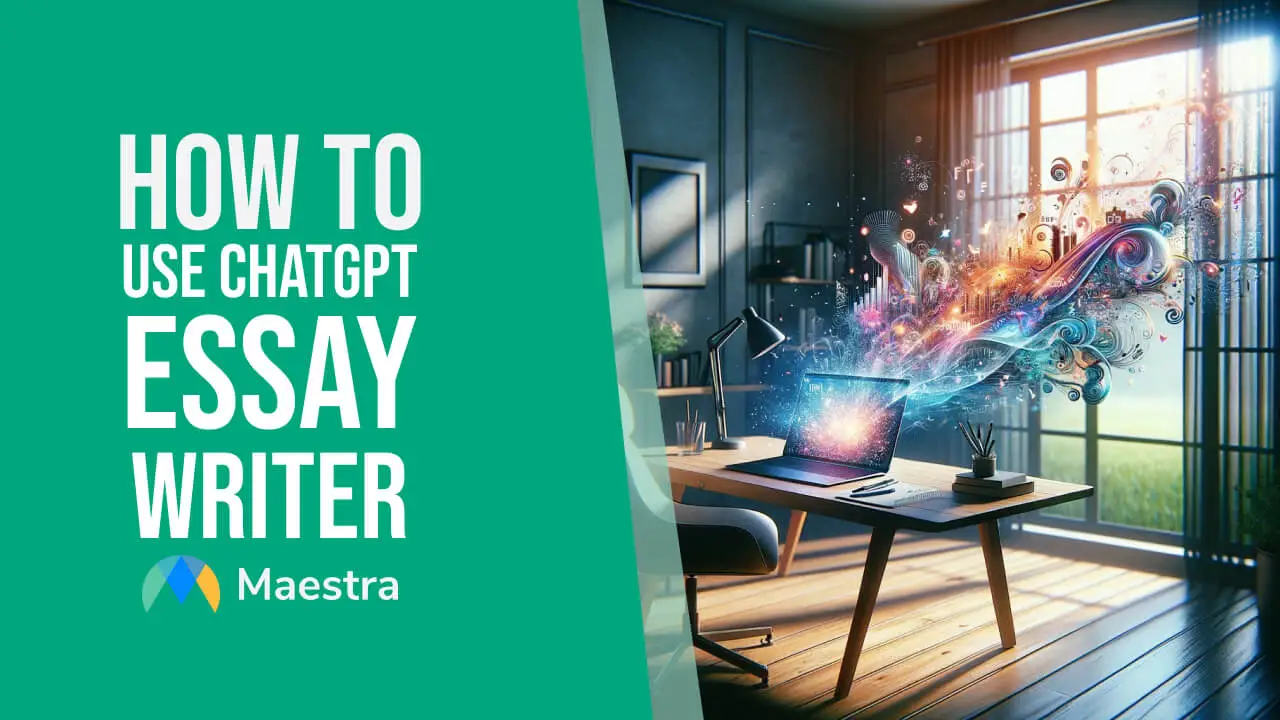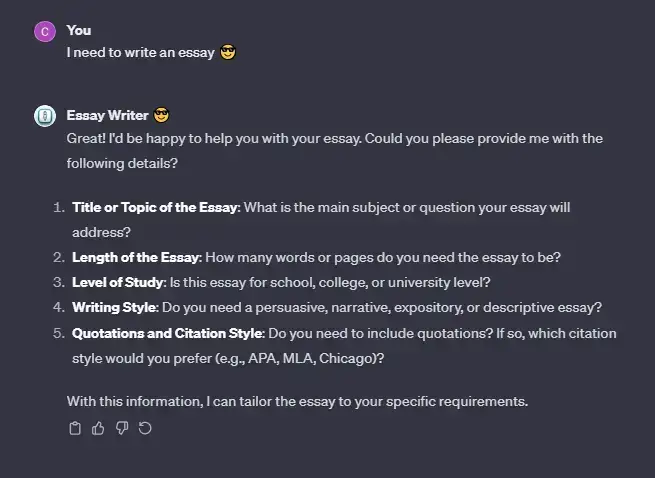How to Use ChatGPT Essay Writer (Tips & Tricks)

ChatGPT Essay Writing Quality
When it comes to writing, ChatGPT is exquisite. Sophisticated and complex sentencing, a deep vocabulary and… Repetition. That is right, ChatGPT is very repetitive, especially when it writes. As someone who regularly uses ChatGPT for content writing, I can say that it is quite easy to spot its writing. The way it compartmentalizes text and the consistent style it keeps through a very deep and complex vocabulary makes it obvious against detection. This might seem a little contradictory since I praise the quality of ChatGPT essay writing because of its rich vocabulary and excellent sentencing, not to mention the knowledge it delivers in an instant, writing always shows some part of the writer, deliberate or not, and this is important because reading is fun and fluid when the text is original (i.e. yours). An imperfect but knowledgeable vocabulary with a natural way of sentencing separates AI writing from human writing. Saying that, it does not mean that you should not benefit from ChatGPT, or use it as an essay writer altogether. The decision is yours, and surely through complex commanding, you can turn ChatGPT into an excellent essay writer that writes unique essays for you.How to Use ChatGPT to Write an Essay
First of all, you need to learn about different commands ChatGPT can understand to write essays. It will tell you about these commands when you ask it to write an essay. Simply asking ChatGPT essay writer to write an essay on a subject has many downsides, So, we must inform ourselves to improve the way we benefit from ChatGPT essay writing.
Ask ChatGPT Essay Writer to Draw an Outline for the Essay
When you directly tell ChatGPT to write you an essay about any subject, the results aren’t as satisfactory. But if you command it to give you an outline of a ChatGPT essay and then ask it to write different parts of the essay with the outline it gives you.
Benefiting From ChatGPT Essay Writing

Creating a Personalized ChatGPT Essay

Ask ChatGPT Essay Writer to Draw an Outline
Have ChatGPT Essay Writer draw an outline for the essay you need to have written.Specify the Level of Study, Writing Style and Quotations
ChatGPT Essay Writer will ask you about these before it starts writing, as well as the length, but let’s save the length of the essay for later. Tell ChatGPT essay writer what kind of an audience the essay is going to be, hence the level of study part. Secondly, specify the writing style of the essay, as in a persuasive, narrative, expository, or descriptive essay. Let’s see the differences between these styles, as told by our good friend ChatGPT:- a) Persuasive Essay:
- Purpose: To convince the reader to accept a certain viewpoint or to take a specific action.
- Approach: Presents arguments and reasoning to support a specific stance.
- Structure: Typically includes an introduction stating the position, body paragraphs with supporting arguments, and a conclusion reinforcing the stance.
- Language: Often uses emotional language and strong words to persuade the reader.
- Examples: Opinion pieces, editorials, reviews, proposals.
- b) Narrative Essay:
- Purpose: To tell a story or relate an experience.
- Approach: Focuses on a personal or fictional experience, often written in the first person.
- Structure: Has a clear beginning, middle, and end; includes characters, a setting, a plot, and often a climax and resolution.
- Language: Employs descriptive and emotive language to engage the reader and convey the story vividly.
- Examples: Autobiographies, short stories, personal anecdotes.
- c) Expository Essay:
- Purpose: To explain, inform, or describe an idea or process.
- Approach: Presents facts, statistics, and logical reasoning to explain a concept.
- Structure: Consists of an introduction to the topic, body paragraphs that explain the topic in detail, and a conclusion summarizing the main points.
- Language: Uses clear, precise, and straightforward language; avoids personal opinions.
- Examples: Textbook content, how-to guides, scientific reports.
- d) Descriptive Essay:
- Purpose: To create a detailed and vivid picture of a person, place, object, or event.
- Approach: Focuses on sensory details to paint a picture in the reader's mind.
- Structure: May not follow a strict chronological order but revolves around the object or subject being described.
- Language: Rich in adjectives and adverbs; uses figurative language like metaphors and similes.
- Examples: Travel writing, nature writing, character sketches.
Quotations
Any scientific content must have quotations about the information it provides. As ChatGPT essay writer asks, you must specify if you want quotations and choose between different citation styles (APA, MLA, Chicago). Let’s see the differences between these citation styles, explained by ChatGPT:- a) APA (American Psychological Association):
- Disciplines: Commonly used in the social sciences like psychology, education, and sociology.
- In-Text Citation: Uses the author-date format (e.g., Smith, 2020). If quoting directly, include the page number (e.g., Smith, 2020, p. 23).
- References Page: Titled "References". Entries include author's last name, first initial(s), publication year, title of the work, and publication information.
- Formatting: Double-spaced with a running head on each page. The title page includes the title, author's name, and institutional affiliation.
- Notable Features: Emphasizes dates (years) in citations, includes DOIs for electronic sources.
- b) MLA (Modern Language Association):
- Disciplines: Preferred in the humanities, especially in literature, arts, and cultural studies.
- In-Text Citation: Uses the author-page format (e.g., Smith 23). No comma is used between the author's name and the page number.
- Works Cited Page: Titled "Works Cited". Entries include author’s full name, title of the work, publication information, and medium of publication.
- Formatting: Double-spaced with no title page. The first page includes the author's name, instructor's name, course, and date.
- Notable Features: More focused on page numbers in citations and includes detailed information on medium of publication.
- d) Chicago Style:
- Disciplines: Widely used in history, business, and fine arts.
- Two Variants:
- Notes-Bibliography System: Preferred in literature, history, and the arts. Citations are in footnotes or endnotes, each corresponding to a superscript number in the text.
- Author-Date System: Used in the physical, natural, and social sciences. Similar to APA, with in-text citations including author's last name and year of publication.
- Bibliography Page: Titled "Bibliography" in Notes-Bibliography System and "References" in Author-Date System. Entries are similar to MLA and APA but with more variation based on source type.
- Formatting: Generally uses footnotes or endnotes for citations. The title page includes the title, author's name, and other relevant information.
